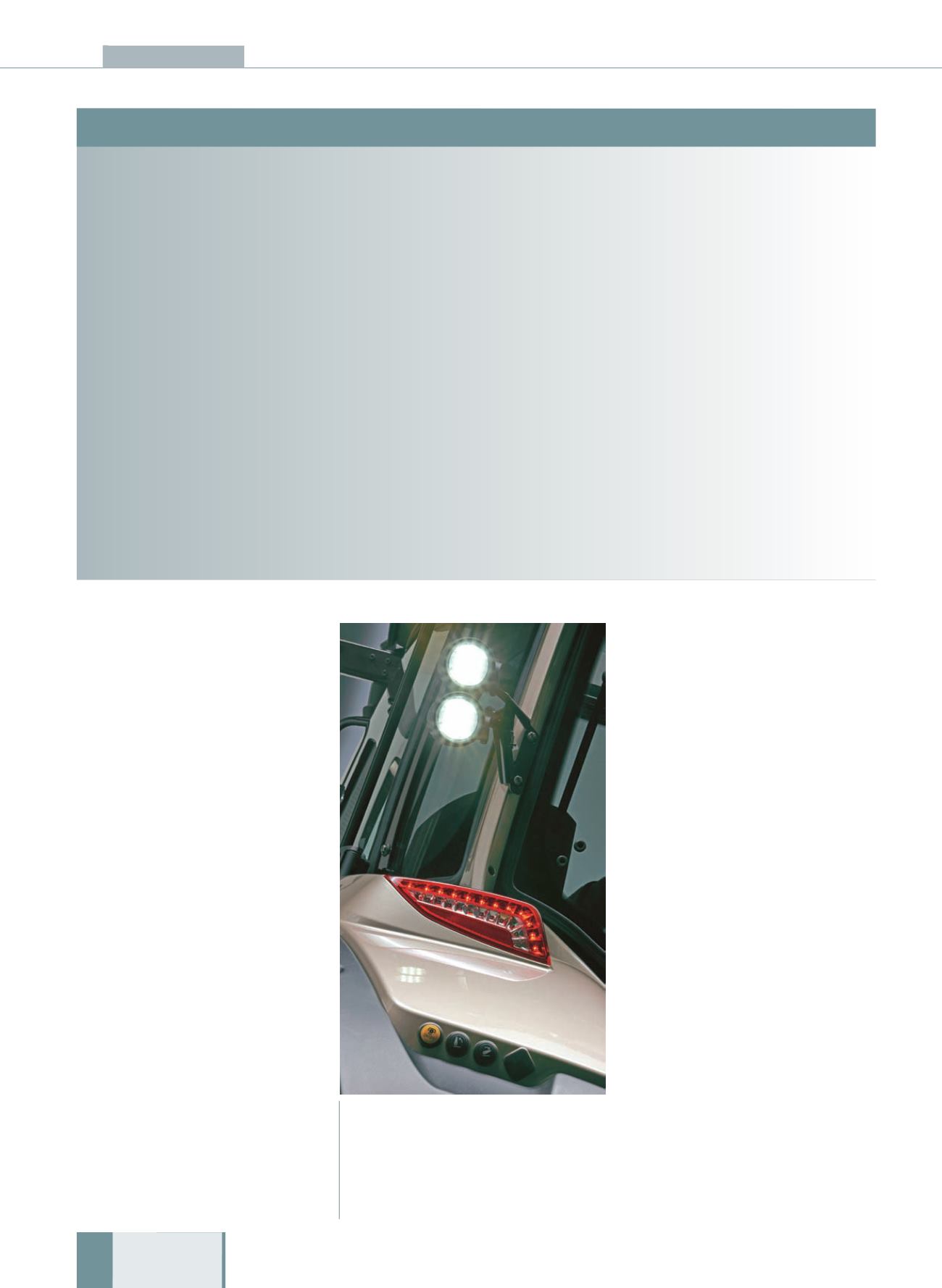
logenopresentenel gas originandoun
alogenuro di tungsteno. Spegnendo la
lampada, l’alogenuro tende a ridepo-
sitare il tungsteno sul filamento, in
modo da aumentare notevolmente la
durata dell’elemento illuminante (che
risulta così anche doppia rispetto al-
le lampade ad incandescenza). Anche
l’efficienza luminosa è superiore, ti-
picamente di 20-25 lumen/watt.
Più di recente, si stanno imponendo
anche in campo agricolo due nuove
tecnologie, ovvero i fari allo xeno e
quelli a LED. I fari allo xeno si avval-
gono di una lampada cosiddetta “ad
arco”, perché è proprio una scarica
elettrica (l’arco) che viene prodotta al-
l’interno di un ambiente confinato e
saturo di gas xeno a creare una luce
molto intensa, simile per contenuto
cromatico a quella solare. L’alimen-
tazione elettrica primaria di queste
lampade è normalmente a bassa ten-
sione (poche decine di volt),ma è ne-
cessario avvalersi di un circuito ele-
vatore di tensione per la fase di ac-
censione, in cui sono necessarie ten-
sioni fino a oltre60.000 V per le lam-
pade più potenti. Per evitare cha l’ar-
co si autoestingua immediatamente
dopo essere stato attivato dalla sca-
rica in alta tensione, è normalmente
prevista una sovracorrente iniziale, o
“boost current”, di intensità pari a
due o al massimo 3 volte quella no-
In the field of agriculture, two new tech-
nologies have been gaining ground even
more recently, Xenon and LED. Xenon
headlights take advantage from the so-
called arc lamp because the light is pro-
ducedby anelectricarc formedbetween
two tungsten electrodes in a bulb of
quartz glass containing xenongasunder
high pressure, plus mercury andmetal-
lic salts.The light produced is very bright
and intense with a chromatic content
similar to that of sunlight. The electric
power consumed by these headlights is
usually low-voltage, down toa fewdozen
V, but they require a high voltage pulse
for starting of up to 60 kV for themost
powerful lights.To avoid allowing the arc
togoout immediately after thehigh volt-
age surge,aboost current usually twoor
three timesgreater than thenominal volt-
age lasting less than 0.25 s is generally
provided. The typical lifespan of these
lamps runs toa few thousandhoursand
they are usually limited by the corrosion
of the electrodes.Moreover, the deterio-
ration of these component materials
evaporate due to the high temperatures
and condense on the inside surface of
thequartz envelope todiminish the light
produced. The corrosion of the elec-
trodes can be speeded up by an incor-
rect polarity of theelectric tensionor ex-
cessive oscillation, ripple, of the intensi-
ty of the current. The luminousity creat-
ed is very high, up to 100 lumins/watt
12
MW
n. 11/2015
S
PECIALE
A partire dal 1° Gennaio 2016 entrerà ufficialmente in vigore il
RegolamentoComunitario167/2013 (piùnotocomeMotherRe-
gulation), diventando il nuovo riferimentonormativoper l’omolo-
gazione (finalmente veramentecomunitaria) dellemacchineagri-
cole, ovvero di trattori, rimorchi e attrezzature trainate.
L’obbiettivo è stato quello di semplificare la normativa preesi-
stente, frammentata in un notevole numero di leggi e regola-
menti, a partire dalla Direttiva 2003/37/CE. Ora è tutto sin-
tetizzato in un’unica normativa (o quasi), che però comporta
parecchie novità per ciò che concerne i mezzi agricoli. Tra que-
ste, una delle più impattanti è sicuramente l’adozione in toto
di diversi regolamenti UNECE, ovvero gli standard internazio-
nali dell’ambitoautomotive; inparticolare,questenormesono
applicate a vetri, avvisatori acustici, dispositivi retrovisori, cin-
ture di sicurezza, pneumatici, nonché a tutti i dispositivi di se-
gnalazione visiva e illuminazione, ovvero i fari e i gruppi ottici.
Dal punto di vista legislativo, laMother Regulation rimanda al Re-
golamentoDelegato208/2015,uncorposodocumentocheentra
nel dettaglio tecnico delle varie questioni. In particolare, per i re-
quisiti relativi ai dispositivi di illuminazioneedi segnalazione lumi-
nosaealle relative fonti di luceeper i requisiti relativi agli impian-
ti di illuminazionesi fa riferimentoagli allegati XI eXII (unitamente
adiversi regolamentiUNECE indicatisemprenel regolamento208).
January 1, 2016marks the official application of Regula-
tion (EU) No 167/2013 of the European Parliament and
of theCouncil,morewell knownas theMotherRegulation
whichbecomes the referencedocument for EUwide type-
approval norms for tractors, trailers and interchangeable
towed equipment.
The purpose of this change is to simplify previous norms
in the form of numerous fragmentedDirectives and regu-
lations dating back to Directive 2003/37/EU. These are
now bundled in a single norm, or nearly, which brings in
manynew features for agriculturalmachinery.Among them
is the fully adopting of various other UNECE regulations.
These are international standards which apply to the au-
tomotive sector, norms on glass, acoustical warning de-
vices, rearviewmirrors, seatbeltsand tiresaswell as light-
ing systems.
From the legislative point of view, theMother Regulation
refersback to theCommissionDelegatedRegulation (EU)
2015/208, a thick document which provides the techni-
cal details of the various issues. Devices designed to illu-
minate the road (headlamp) or to emit a light signal are
taken up in Annex XI and XII, along with the various UN-
ECE regulations referred to inRegulation 208.
Le nuove normative
The new norms
Dispositivi luminosi posteriori di unmoderno trattore:
nel parafangoè integrato il gruppoottico con le luci di
posizione, di arrestoe gli indicatori di direzione; sul
montantedella cabina sono invece installati due
proiettori da lavoro
Rear lightingonamodern tractor:mountedon the
rear fenders is an integrated lightinggroupwith
parking lights, brake lights and turn signals and
working lights are installedon the cab


